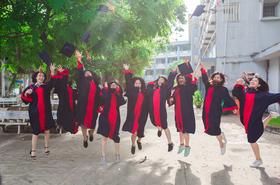School Highlights
Miller-Motte Technical College-Madison served 319 students (76% of students were full-time).
The college's student-teacher ratio of 14:1 was lower than the state community college average of 18:1.
Minority enrollment was 46% of the student body (majority Black), which was more than the state average of 45%.
School Overview
Miller-Motte Technical College-Madison
(TN) Community College Avg.
Carnegie Classification
Item not available
Not applicable, not in Carnegie universe (not accredited or nondegree-granting)
Institution Level
Less than 2 yrs
At least 2 but less than 4 years
Institution Control
Private, for profit
Public
Total Faculty
23 staff
152 staff
School Calendar
Student Body
Total Enrollment
319 students
699 students
Student-Teacher Ratio
14:1
18:1
# Full-Time Students
242 students
426 students
# Part-Time Students
77 students
273 students
# Enrollment Undergraduate
384 students
504 students
# Full-Time Undergraduate Students
242 students
426 students
# Full-Time Graduate Students
n/a
12 students
# Part-Time Undergraduate Students
n/a
335 students
# Part-Time Graduate Students
n/a
12 students
Total Dormitory Capacity
n/a
195 students
% Asian
n/a
4%
% Hispanic
4%
6%
% Black
36%
19%
% White
54%
55%
% Hawaiian
n/a
9%
% Two or more races
1%
3%
% Non Resident races
n/a
1%
% Unknown races
5%
3%
Diversity Score
0.57
0.65
College Completion Rate (Students who graduate in less than 4 years)
44%
22%
College Completion Rate (Students who graduate in 4 years or more than 4 years)
n/a
52%
Average Graduate Earnings (10 Years)
$25,100
$29,000
Tuition and Acceptance Rate
Private State Tuition Fees
$10,800
$13,174
% Students Receiving Some Financial Aid
97%
93%
Median Debt for Graduates
$23,472
$10,500
Median Debt for Dropouts
$7,435
$5,500
Acceptance Rate
61%
71%
SAT Reading
n/a
415
SAT Math
n/a
455
SAT Writing
n/a
469
ACT Composite
n/a
20
ACT English
n/a
19
ACT Math
n/a
19
Source: 2023 (or latest year available) Integrated Postsecondary Education Data System (IPEDS)
Frequently Asked Questions
How much does Miller-Motte Technical College-Madison cost?
Miller-Motte Technical College-Madison's private state tuition is approximately $10,800.
What is the acceptance rate of Miller-Motte Technical College-Madison?
The acceptance rate of Miller-Motte Technical College-Madison is 61%, which is lower than the state average of 71%.
All school names are trademarks and/or registered trademarks of their respective holders. This school is not affiliated with Community College Review and has not endorsed, approved or sponsored this website or directory listing in any manner.
Recent Articles

The Rise of Technical and Vocational Training in 2025
Explore the 2025 surge in technical and vocational training—enrollment, policy, costs, and why this path is gaining ground for students and parents.

Stackable Credentials: How Community Colleges Advance Careers
Discover how community colleges use stackable credentials to build career pathways, boost earnings, and enable lifelong learning in 2025.

High-Paying Jobs You Can Get with a Community College Degree
Discover top high-paying careers you can launch in 2025 with a community college (associate) degree and high-growth credentials in tech, healthcare and trades.






